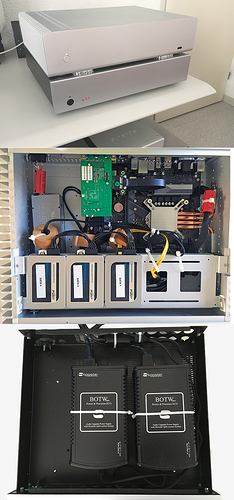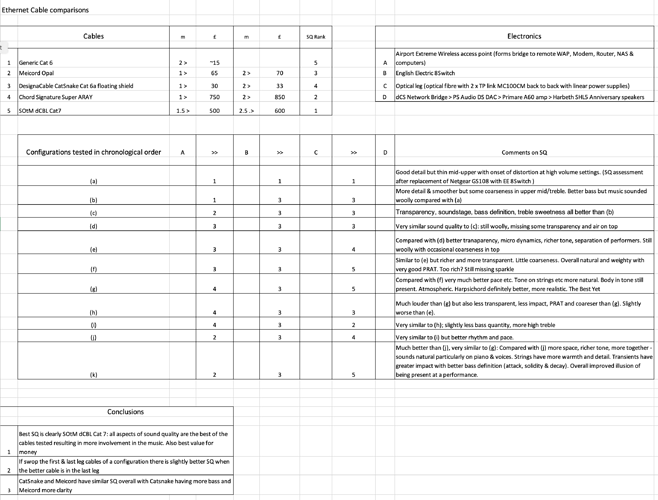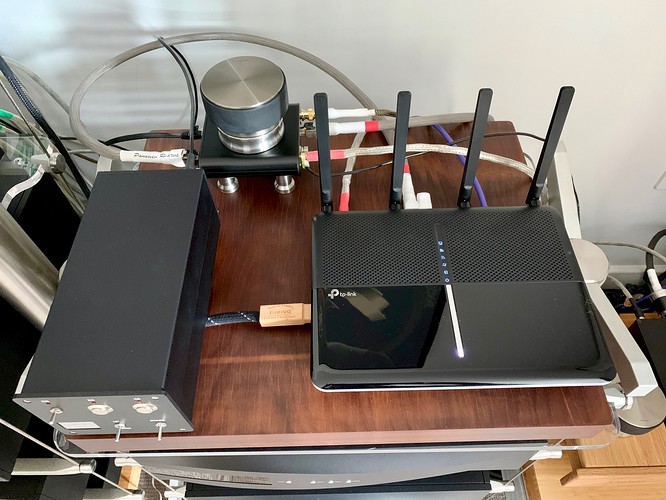Interesting. So, your PC is connected via the Sigma to what? Your router or a switch? How is your Vivaldi connected to your network, or is your PC connected to the Vivaldi via USB or Toslink?
I do not use a switch, I use the Devolo Gigagate with 2 ifi power adaptors to the PC.

So:
With a normal Cat 5 cable from the Provider internet modem to a Nighthawk AC3200 Tri-Band Router.
Then with a Shunyata Sigma Ethernet Cable to a Devolo Gigagate Base that transmits a WiFi signal to a Devolo Gigagate Satellite.
Then with a Shunyata Sigma Ethernet Cable to the JCat Ethernet card in my Roon Core / player PC
From the JCat USB XE card in my Roon PC to the Vivaldi DAC with a Shunyata Alpha USB Cable (soon the Sigma USB).
The two JCat Cards are powered with two Sbooster 5V power supply’s.
The PC with a HD Plex Power Supply.
Thanks for the detail and pics. So—and I apologize if I missed this before—your Sigma Ethernet cables are used to connect your PC to the “external world,” e.g., Qobuz or other streaming sources, while your actual music playback is performed by Roon on your PC connected to the Vivaldi via an Alpha USB cable [not the best source input for the Vivaldi]. And you hear a difference in your SQ using the Sigma Ethernet cables? Again, what explanation could account for the difference when, immediately upstream, you have a generic, provider-supplied Cat5 cable?
Anyway, all that money for cables and PSUs could put a Network Bridge on your network to feed the Vivaldi [stack] through its superior Ethernet input, still with the Gigagate for isolation [but where it could matter much more], and set the stage at some point to implement a networked Roon device. But, to each their own! 
I don’t believe that an Ethernet input is always better.
I connected this same PC with USB to my Rossini DAC and that sounded better. I tried that because I had to connect a different source with my new purchase of the Vivaldi DAC. The Network bridge was one of the options, but it has not become. The PC has another advantage that you can easily update hardware and software. I know, not everyone wants that, but my experiences have been very positive.
The PC actually only sounds so good because I use Fedelizer software on it. There will be a better Ethernet card from Jcat coming out soon and it would be better. I think Shunyata is a master at removing distortion that are present in Power and Ethernet networks.
Logical that when using Tidal the difference should be greater, but I don’t think so. As soon as you use the cable it is better, with Tidal and when using the files on the PC.
Is that possible, or am I crazy? Maybe, but this is my experience.
Remove interference with a cable that is not connected to a device?
Check this out: https://www.youtube.com/watch?v=bmVHcY1CMAs
I believe this can also be done with an Ethernet cable.
The PC as I have it and the USB cable together are cheaper than the Network Bridge (without cables).
But it is not for everyone, so just buy a Network Bridge, after all, we are also on the dCS forum.
This is my last contribution on this subject because everyone has their own way of thinking about ethernet cables.
I just wanted to let mine know so it might help someone.
 I love my dCS Vivaldi and Clock! I know, I am a lucky guy!
I love my dCS Vivaldi and Clock! I know, I am a lucky guy!
Maybe not on all equipment, but the dCS folks here have said that on dCS equipment, it is. And it’s IME easier and cheaper for the end user to optimize for Ethernet than USB. Anyway, if you’re happy, that’s all that matters. Your system, your money, your ears. Cheers!
After extensive reading of this and other threads on the effect of ethernet cables on sound quality I’ve completed some comparative auditions of my own. I swopped around 5 cables in the 3 legs of the ethernet LAN section connecting my music player to a wireless bridge via an optical leg and switch. On the other end of the wireless bridge is a remote LAN section comprising Modem, router, switch and a NAS holding the music library. The cables covered a wide price range, two (the SOtM & Chord) were loaned on sale-or-return, and the others I’ve had in use for from months to years. Rather than write a long description of what I did and the results, I’ve created the attached spreadsheet (you will need to zoom in to see the details).
To summarise I decided to keep the SOtM dCBL CAT7 cable. In my system, dCS Bridge > PS Audio DirestStream DAC > Primare A.60 amp > Harbeth SHL5 Anniversary model, I found this cable clearly sounds better than the Chord Signature Super ARAY cable. Compared with the Chord cable it conveys more space, with richer tones. Sounds are more natural, particularly on piano & voices. Strings have more warmth and detail. Transients have greater impact with better bass definition (attack, solidity & decay). Overall it improved the illusion of being present at a performance. Most of my music library consists of acoustic classical music and jazz so this is important to me.
Other conclusions I came to were (1) swopping two of the better cables between the first and last legs made only a small difference to sound quality with placement of the better cable in last leg giving marginally better SQ, (2) there was little to choose between the Meicord and the CatSnake cables: the Meicord had more clarity while the CatSnake had more bass but was slightly woolly in comparison.
I must admit I did not expect to hear such a significant variations in sound quality from swopping around ethernet cables - it is of the same order as I heard when I replaced the Netgear switch with the EE 8Switch, so I guess I will need to repeat the exercise for the cables in other parts of the LAN. Of course I should add the caveat that these results are for for my system, in my listening room, with my music and my ears.
Tellurium Q Streaming cable. Setup is Rossini, Melco NAS to Cisco 2960.
I tested the Chord range as well, Tellurium gives me more air, space, more flow.
Sounds better than USB by the way…
Just before Christmas I switched over to a Shunyata Sigma between my optialModule and Upsampler. Very pleased.
For streaming, I use Mark Coles excellent, Sablon Audio Panatela Reserva 2020 Ethernet cables (1 metre) from TP-Link AC2800 modem/router to Uptone Audio EtherREGEN (‘A’ side) then a second Sablon 1 metre LAN cable from EtherREGEN ‘B’ side, to Ethernet input on my dCS Vivaldi Upsampler. The Sablon cable is shielded and costs in the region of £350, direct from Mark (no middle man to push up the price). Mark improved his LAN cable during lockdown, by the substitution of Telegartner CAT 8 RJ45 connectors.
Nice use of Stillpoints. Another fan here.
Nice looking cable, though I will stick with the unshielded going into the Upsampler. Steve, what are you using to “clock” the EtherREGEN?
Hi Greg. I use a Mutec Ref 10 SE-120 reference clock to supply a 75 Ohm 10MHz clock signal to my dCS Vivaldi full-stack, with a second 75 Ohm output, to re-clock the EtherREGEN, via a Sablon Audio clock cable. The Mutec and router are also grounded to a 0 Ohm reference signal ground (Coherent Systems RTZ3).
Unsurprisingly, I also use a Sablon Audio 2020 USB cable, from Melco N1ZH/60 EX to Vivaldi USB input.
Thanks. Appreciate the info.
Greg is speechless 
I must say that I never thought it was possible to add such a sophistication between a streaming service and the input of a Dac. It is an amezing set up.
 Well, I do already have an SRS Perf10 as reference for my Vivaldi Clock, and I have it connected to my EtherREGEN, just for giggles, and the ER is connected to my Cisco switch via fiber. When the Novus reference clock arrives, it will be swapped in for the Perf10 and connected identically I am always interested to see what other folks do. No sale for me though on “audiophile” Ethernet or clock cables, so long as the cables are certified and/or measured spec-compliant.
Well, I do already have an SRS Perf10 as reference for my Vivaldi Clock, and I have it connected to my EtherREGEN, just for giggles, and the ER is connected to my Cisco switch via fiber. When the Novus reference clock arrives, it will be swapped in for the Perf10 and connected identically I am always interested to see what other folks do. No sale for me though on “audiophile” Ethernet or clock cables, so long as the cables are certified and/or measured spec-compliant. 
A question about this compliance issue. The people against expensive cat7 cables of some hifi companies always say that their cables are not certified…Is it true? Why companies like Audioquest or Wireworld would not get the certification for their cables ?
The reason may be that Cat 7 is not the official name of the cable. It is an informal description in common use. However it is not recognised by TIA/EIA which is where the identifier Cat X comes from so it cannot be certified as Cat 7. It is however a recognised ISO/IEC cable .Its correct designation is ISO/IEC 11801 Class F.
In respect of its use with dCS network equipped products it is of incorrect specification being shielded. There are numerous postings in this thread on this subject including from dCS engineers.
Incidentally I recently changed from moderately expensive Cat 7 cables to Belden Cat 5e ( which is unshielded) which , subjectively, I found preferable. As always YMMV.
Chris, I’m not against these cables. As a guy who believes in free choice and markets, I am happy to see people spending money on whatever they want.  There is just zero evidence, and I do mean zero, other than pure, unverifiable anecdotal reports, that an audiophile Ethernet cable has any audible effect on the data that it transmits or on the output of the DDC and/or DAC to which it is connected. Now, some of these cables are absolutely lovely, like that Sablon, and I totally grok the satisfaction that comes from using a fine tool. There is a lot to be said for using something that feels and/or looks great.
There is just zero evidence, and I do mean zero, other than pure, unverifiable anecdotal reports, that an audiophile Ethernet cable has any audible effect on the data that it transmits or on the output of the DDC and/or DAC to which it is connected. Now, some of these cables are absolutely lovely, like that Sablon, and I totally grok the satisfaction that comes from using a fine tool. There is a lot to be said for using something that feels and/or looks great.
I haven’t stated any opposition to these cables at all. In fact, no one actually has, except where we know that the cable in question does not comply with some recommendation by dCS. In some cases, we know that a cable is shielded, while dCS recommends unshielded for its components. Ergo, not compliant with this manufacturer’s recommendations. BTW, it does seem that quite a few of these audiophile cables are Cat7, which last rime I checked is not recognized by the Telecommunications Industry Association anyway.
What I have often asked when someone claims that an Ethernet cable provides more air, or definition, or depth, or whatever, is “why?”. With what we know about TCP/IP architecture, one has to ask how a cable could make those differences. This is different from noise. The wrong type of cable (shielded vs. unshielded), or one not properly built, could introduce noise into one’s system that might be audible. But jitter and timing?
Further, compliance with the spec for the various Ethernet cable classes is a relatively simple matter. But whether a specific cable meets the spec is a matter many consumers take on faith. As to why makers of the cables don’t get them certified or supply their specs, well, beats me. That’s their choice, I guess.
I buy from Blue Jeans, because they provide the test results of every single Ethernet cable they build inside the package. All pretty and printed in color. Every single one. You know the cable you are buying is built to spec. That’s where I get my satisfaction with respect to Ethernet cables. Now, wouldn’t I like it if the BJC cables looked like the Sablon? Hell yeah! And I get why someone else might find that worthwhile. Just not me. If someone wants to spend more on them and derives utils from that, go for it!
But if you want to sell me on audible differences, better at least have a reasonable hypothesis why. People who say “I don’t know why, but I trust XYZ company and other [unverifiable] reports” don’t give me much to go on when assessing if/how my ears/brain may perceive the same cable in my system. Or, if the cable appears to solve some sort of noise problem, by all means, go for it. But then, one could ask: hmmm, what is causing that? And work from there. It may well be that a shielded cable is in fact the exact right answer for someone’s system. But like a hammer, that’s the right tool for the job. And like a hammer, or a car, or a camera, or an expedition sleeping bag, how well-built it is and how attractive it is, might matter very much and might be worth a lot to you. But, to these ears, it isn’t changing the reproduction of music.
I will share my travails with Ethernet ( Cables and Switches) so that at least some forum members can avoid the same pitfalls.
Ethernet Cables:
a. Ordered a JCAT ethernet cable from Poland after reading Jay Luong’s glowing review on Audio Bacon. After taking my payment there was complete silence and no cable. Only when I complained to PayPal the JCAT owner paid attention. He then shipped the cable to the wrong address. I finally received the cable. It is short and very “beautiful”. The SQ is excellent but does not make up for the poor customer service, t he short length, and the cost= 1300 or so in US
b. Shunyata Sigma Ethernet: Bought used. Also a terrific cable. No complaints, $750 used.
c. SOtm dCBL-CAT7 Audiophile Ethernet Cable: Bought new. Prompt delivery. $500. Exceptional SQ- am going to keep this one!
d. Tellurium Q Ethernet: Bought used for $400. Very good but not exceptional
Plan to sell a, b and d.
Lesson learnt: All that “glitters in reviews” is nowhere near “Gold”.
SOtM dBCL cable at $500 is a fantastic value for the dCS Bartok.
Ethernet Switches:
a. Ether REGN from Uptone Audio: $660. Excellent but runs very hot. I sold mine.
b. Melco S-100: Available for $1980 from Underwood Hi Fi in the US. This is a very well made device. Sound quality is excellent. Is it worth $2000? We can debate that for ever.
c. Alternatives that I did not try, but may be worth trying would be one or two of the myriad offerings from Sonore. If anyone has experience with Sonore devices with dCS products, please share.
Hope the above helps…at least someone
Best
Rit
Today I finally did it. I swapped my Audioquest Vodka ethernet cable for a Belden Cat6 U/UTP, between my switch and Bartók.
It sounded at least as good, maybe even better.
It is 50 times less expensive.



